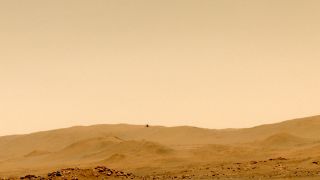
The future of aerial Mars exploration looks bright.
NASA's Mars helicopter Ingenuity, which landed inside Mars' Jezero Crater with the agency's Perseverance rover in February, has now completed eight Red Planet flights. That's three more than the maximum targeted for the 4-lb. (1.8 kilograms) chopper's original technology-demonstration mission — and Ingenuity isn't done yet.
The little rotorcraft's current extended-mission activities, which center on showcasing the potential of Mars helicopters to serve as scouts for rovers, will "continue for at least a few more months, with a cadence of a couple of flights a month," Perseverance project scientist Ken Farley, a geochemist at the California Institute of Technology in Pasadena, said last Monday (June 21) during a webcast meeting of NASA’s Mars Exploration Program Analysis Group (MEPAG).
Video: Watch NASA's Mars helicopter Ingenuity fly in 3D
Balancing the needs of a helicopter and rover mission simultaneously requires a complicated "dance," and the upcoming Ingenuity flights will give members of both teams valuable practice, Farley said. (Ingenuity and Perseverance are separate missions, but the helicopter relies on the rover — which is just now digging into its life-hunting, sample-gathering work — as a communications relay.)
"Along the way, we hope to acquire reconnaissance imagery of places that we cannot go," Farley said. "And we are also using the helicopter to develop terrain meshes that could, in the future, allow rovers to drive across landscapes that they cannot actually see from their mast-mounted cameras."
To date, the farthest distance that Ingenuity has traveled on a single sortie is 873 feet (266 meters; achieved on Flight 4, on April 30), and the longest it has stayed aloft is 140 seconds (Flight 6, May 22). The Ingenuity team would like to shatter both of those marks in the next few months, if possible.
Get the Space.com Newsletter
Breaking space news, the latest updates on rocket launches, skywatching events and more!
"We've gone 266 meters; we're looking to stretch that to a kilometer [0.6 miles]," Ingenuity operations lead Teddy Tzanetos, of NASA's Jet Propulsion Laboratory (JPL) in Southern California, said during the MEPAG meeting on June 21.
"That would mean three minutes flight time total," Tzanetos said. "And that would really be pushing the limits of what the technology demonstrator is capable of, in terms of a flight vehicle."
The helicopter team will also prioritize scouting regions of interest to Perseverance, such as the geologic unit on the floor of Jezero known as Séítah, and mining the reams of scientific and engineering data generated by Ingenuity, Tzanetos added.
The data-mining work could inform the design of Ingenuity's successors, which are already starting to take shape — as concepts at least. For example, engineers have begun drawing up plans for a much larger, much more capable rotorcraft called the Mars Science Helicopter, Tzanetos said during his MEPAG talk.
The Mars Science Helicopter is a joint project involving JPL, NASA's Ames Research Center in Silicon Valley and the defense contractor AeroVironment. The envisioned craft would sport six rotors, weigh about 66 lbs. (30 kilograms) and be able to carry science payloads weighing up to 11 lbs. (5 kg) or so, Tzanetos said. (Those are the weights here on Earth; the hexacopter would be lighter on Mars, whose gravity is just 38% as strong as our planet's.)
The Mars Science Helicopter would be capable of flying about 6.2 miles (10 kilometers) in a single sortie, Tzanetos said. Such an aircraft would be able to explore "locations that rovers couldn't access, like cliffside walls, or difficult-to-traverse terrains, or even down into caves," he said.
Again, the Mars Science Helicopter is just a concept at the moment, not a full-fledged mission. But thanks to Ingenuity's ongoing work, the hexacopter might find its way to the Red Planet at some point in the not-too-distant future.
Mike Wall is the author of "Out There" (Grand Central Publishing, 2018; illustrated by Karl Tate), a book about the search for alien life. Follow him on Twitter @michaeldwall. Follow us on Twitter @Spacedotcom or Facebook.
Join our Space Forums to keep talking space on the latest missions, night sky and more! And if you have a news tip, correction or comment, let us know at: community@space.com.

Michael Wall is a Senior Space Writer with Space.com and joined the team in 2010. He primarily covers exoplanets, spaceflight and military space, but has been known to dabble in the space art beat. His book about the search for alien life, "Out There," was published on Nov. 13, 2018. Before becoming a science writer, Michael worked as a herpetologist and wildlife biologist. He has a Ph.D. in evolutionary biology from the University of Sydney, Australia, a bachelor's degree from the University of Arizona, and a graduate certificate in science writing from the University of California, Santa Cruz. To find out what his latest project is, you can follow Michael on Twitter.